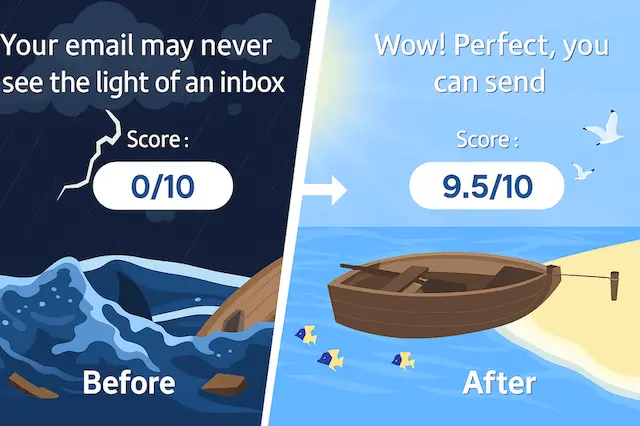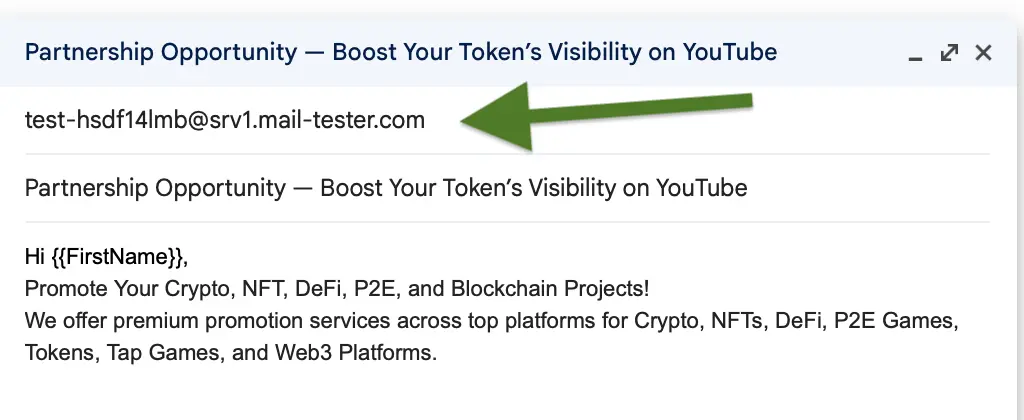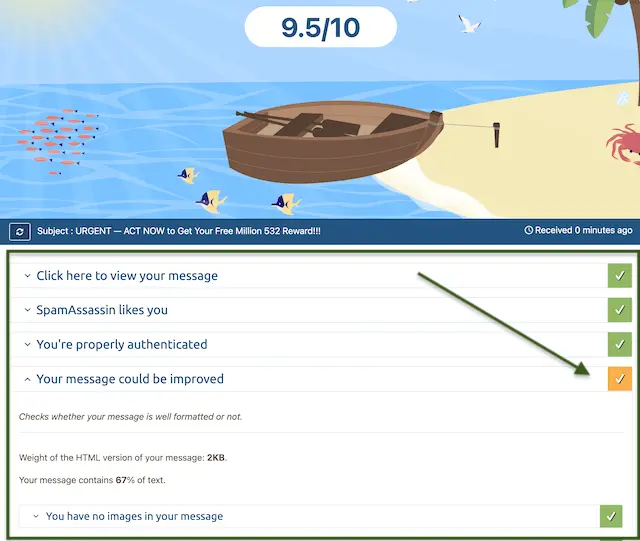How to Test Email Deliverability for Free with Mail‑Tester

Test Email deliverability first, sell later—that principle separates thriving crypto vendors from inbox ghosts. When you pitch audits, listings, or growth services to token founders, your note must appear in their primary tab, not the spam graveyard. However, ensuring inbox placement is only effective if your audience is properly validated beforehand, as described in our guide on audience validation for crypto outreach. Also, mail hosts distrust blockchain chatter because scammers abused similar language for years. Therefore Gmail, Outlook, and corporate gateways scan every subject line and server signature you send. If they spot missing SPF records, broken links, or hype like “guaranteed profits,” they silently divert your message. Fortunately, the free spam checker Mail‑Tester provides a pocket diagnostic lab. Within two clicks you uncover technical gaps, risky words, and blacklist threats. This ultimate guide shows companies, agencies, and freelancers how to wield Mail‑Tester, refine deliverability, and accelerate B2B crypto revenue.
Why Deliverability Matters in Crypto Sales
Cold outreach is not dying—scripts and deliverability decide winners. Additionally, mastering advanced techniques such as hyper-personalization, multi-channel follow-ups, and strategic timing can significantly improve your outreach effectiveness, as explained in our cold outreach tactics guide for crypto business. Many providers blame market fatigue when open rates fall below ten percent, yet the real culprit often hides in DNS records. For example, last quarter our agency removed one malformed DKIM entry for a DeFi audit firm. Immediately its pipeline resurrected from eight demos per month to twenty‑one, closing a forty‑two‑thousand‑dollar retainer in nine days. Therefore, before you redesign subject lines or splurge on lead lists, fix unseen gatekeepers. Moreover, pairing this strategy with a systematic approach to building your ideal customer profile can further sharpen your targeting, as outlined in our guide to building ICPs for crypto startups. Mail‑Tester exposes them without cost or login. Because the platform mirrors SpamAssassin engines and blacklist checks that recipients use, its verdict approximates reality. Treat each score as a live X‑ray, not a vanity badge, and you will rescue months of marketing budget otherwise lost to junk folders. In addition, improved inbox placement boosts reputation with venture partners who monitor your domain.
Neglecting authentication today suffocates tomorrow’s pipeline. Crypto projects, tokens issuers, and other crypto-related entities whitelist only senders passing SPF, DKIM, and DMARC. When your record fails, their firewalls bounce your pitch unseen. Each hour you delay a deliverability audit deletes potential revenue.
What is Mail‑tester?
First, Mail‑Tester is a free Spam checker you can use in seconds. Next, it gives you a unique disposable address. Then you forward your drafted outreach email to that address. Afterward, you click Then check your score. Immediately, the tool runs SPF, DKIM, DMARC, SpamAssassin, blacklist, and formatting tests. Consequently, you receive a clear 0–10 score with detailed notes. Thus, you see missing authentication, spammy words, or broken links. Moreover, you learn exactly what to fix before sending. Hence, crypto founders and sales teams avoid inbox traps. Therefore, more messages land where prospects can read them. Finally, better placement sparks higher opens, replies, and deals. Also, pivoting your business to incorporate AI strategies tailored for crypto projects can dramatically boost outreach effectiveness and revenue.

The Three‑Stage Crypto Inbox Framework
Stage 1 – Write with Compliance
You begin inside your CRM or ESP instead of a generic template library. Draft the exact outreach you intend to ship, including subject line, links, and signature. Keep paragraphs concise, avoid excessive capitalization, and replace hype with quantified value. Furthermore, embed compliance from the first keystroke. Ensure your domain already publishes SPF, DKIM, and DMARC records. Confirm the “From” address matches branding, because mismatched aliases confuse filters. When possible, add a straightforward opt‑out sentence that honors privacy laws without breaking conversational tone. In addition, balance HTML with plain text and supply descriptive alt text for every image. This structure reassures scanners that your note behaves like legitimate business correspondence rather than a pump‑and‑dump blast.
Authentication Setup
Configure SPF to list all authorized sending servers. Then generate a DKIM key pair through your ESP and publish the selector in DNS. Finally, set DMARC to quarantine failures while you monitor reports. These three records signal identity, integrity, and policy. Therefore, servers like Google Workspace grant you higher trust scores.
Content Hygiene
Replace phrases such as “double your money” with precise benefits like “reduce exchange spread by five basis points.” Avoid triple exclamation marks and red fonts. Instead, use clear calls‑to‑action, for example “Schedule a fifteen‑minute demo this week.” Similarly, when a YouTube promoter pitches a token review, promise “reach 50,000 engaged viewers” rather than “100× overnight.” Therefore founders appreciate measured numbers; moreover, algorithms flag less hype. Because you speak to technical founders, accuracy outweighs hype.
Stage 2 – Score with Mail‑Tester
After composing, navigate to Mail‑Tester, copy the disposable address. But, don't close that page.

Then, send your Test Email (to the email address provided by Mail-Tester) from the production mailbox.

Return to the site and press "Then check your score". The cheerful snail animates, then reveals a number between zero and ten. Treat any result below eight as an amber alert. Otherwise, combining Mail-Tester checks with our comprehensive crypto B2B lead generation playbook ensures sustained lead flow and campaign success.

Scroll to inspect color‑coded modules—authentication, SpamAssassin, blocklists, HTML, and links. Green lines pass; orange lines need tweaks; red lines demand urgent fixes. Because explanations appear in plain language, even non‑technical founders understand why Gmail distrusts a missing List‑Unsubscribe header. Capture each warning in your task tracker, assign ownership, and set deadlines. This transparency accelerates collaboration among marketing, engineering, and legal. In addition, leveraging Google Workspace Duet AI can automate much of this compliance documentation, dramatically reducing your manual workload, as discussed in our Google Workspace Duet AI guide for crypto sellers.

Reading the Numbers
Mail‑Tester inverts SpamAssassin calculus, so positive values raise your score. For example, “+1.9 SPF_PASS” means filters perceive authentication strength. Conversely, “‑2.5 URGENT_CLAIM” warns about hype language. Therefore, aim for at least eight points before launching campaigns. Remember, a perfect ten does not guarantee inbox placement, yet anything below six often predicts disaster.
Stage 3 – Improve and Iterate
You now possess a roadmap of deliverability gaps. Therefore, update DNS records, rewrite flagged phrases, swap blacklisted links, and include a text alternative part. After adjustments, resend the email to a new Mail‑Tester address. Repeat until warnings vanish and the score reaches your threshold. This loop rarely exceeds thirty minutes once your team understands responsibilities. Finally, store the result link inside your CRM deal record as evidence of due diligence. Doing so impresses compliance officers at regulated counterparties who may audit your outreach process. Also, small businesses can leverage strategic agility and niche specialization to compete effectively even against larger players.
Create an automation in ClickUp or Jira that triggers whenever copywriters move an email template to “Ready.” The task auto‑assigns a deliverability owner who must attach a Mail‑Tester screenshot above eight points before the item can exit the sprint.
Advanced Deliverability Tactics
Avoiding Spam Trigger Words
Words matter. Therefore filters sniff hype phrases instantly. However, many crypto senders still write “earn 100 % today.” Consequently, SpamAssassin lowers their score. Moreover, Gmail warns recipients. Thus, scrub vocabulary before the final send. In addition, replace hype with factual metrics such as “cut costs 12 %.” Furthermore, maintain a friendly, technical tone. For guidance, review our free list of 370 + spam trigger words and suggested replacements. You can download that list in CSV or Excell without any cost and improve outreach's content instantly. Hence, share it with writers and SDRs. Finally, remember clean wording pairs with strong authentication for peak inbox placement.
Aligning with Regulatory Filters
Crypto recipients operate under MiCA, FATF Travel Rule, and local securities statutes. Therefore, compliance teams often configure stricter firewalls. Avoid promising guaranteed yields, which regulators flag as unregistered offerings. Instead, emphasize risk disclosures and verifiable metrics, for example “Smart‑contract audit covering reentrancy, integer overflow, and oracle manipulation.” Furthermore, segment outreach by jurisdiction and exclude sanctioned geographies at the lead‑scoring stage. Doing so prevents wasted effort and reduces blacklist risk.
Leveraging Data for Targeted Segments
Deliverability improves when engagement signals remain high. Therefore, feed wallet labels, funding milestones, and on‑chain activity into your CDP. Prioritize hot accounts—treasuries that received at least two‑hundred‑fifty‑thousand USDC last week—and pause cold addresses that never opened. Because modern ESPs adjust reputation on a per‑recipient basis, continuous pruning keeps metrics healthy. Moreover, incorporating leads sourced directly from BscScan can enrich your funnel with highly qualified and compliant contacts. In addition, personalized merge fields like chain name or audit status boost relevance, which further increases opens. In addition, enriching your data with verified project information directly from CoinGecko or from CMC helps prioritize your outreach to the most active projects.
Monitoring Reputation Over Time
Blacklists update continuously. Consequently, schedule weekly automated pings to MXToolbox and DNSBL services. Additionally, regularly reviewing monthly blockchain launch trends can ensure your targeting remains precise and timely. If any listing arises, initiate delisting requests or switch to a reserved IP pool while the issue resolves. Track sender score trends inside dashboards, and correlate dips with campaign bursts to identify root causes. Because crypto news cycles cause sudden traffic spikes, proactive monitoring prevents surprises during token generation events.
Integrating Tests into Your CRM Pipeline
Kommo, HubSpot, and Salesforce support webhook actions. Therefore, create a workflow that fires whenever marketers mark a campaign as “Approved.” The webhook posts the template content to an internal endpoint, which triggers a serverless function that sends a Test Email to Mail‑Tester. The function parses the JSON result and writes the score back into the CRM object. If the score falls below eight, the system reopens the task and notifies the template owner on Slack. This closed‑loop integration embeds deliverability inside daily operations rather than relegating it to occasional checks. Consequently, new hires inherit safe practices automatically, and leadership sees continuous compliance metrics on dashboards. Furthermore, you can deepen this integration by incorporating email warm-up strategies into your workflow, significantly enhancing inbox placement.
Frequently Asked Questions
How many times can I Test Email deliverability per day?
Mail‑Tester allows three free tests daily. However, you can create additional accounts or upgrade if your team iterates heavily during launches.
Does a 10/10 score guarantee inbox placement?
No, but it removes common technical blockers. Recipient behavior, domain age, and personalized spam rules still influence final delivery.
Should I include an unsubscribe link in one‑to‑one messages?
Yes, when you send at scale. A simple opt‑out line reduces complaints and earns positive points from Mail‑Tester.
Can shortened URLs hurt Email Deliverability?
Sometimes. Public shorteners share reputation across millions of users. Therefore, use branded redirects or direct links whenever possible.
How often must I retest?
Run a Test Email before every new template and after any DNS change. Additionally, schedule monthly health checks to catch silent reputation drift.
Conclusion
Email deliverability can make or break your crypto B2B outreach efforts. The good news: with Mail‑Tester, testing and improving your message’s deliverability remains straightforward and free. Within two clicks—sending a Test Email and checking the score—you discover hidden issues that sabotage engagement. By embedding the Three‑Stage Crypto Inbox Framework into your funnel, you ensure every proposal reaches the founders who need your expertise. Therefore, before you blast that listing package, allocate fifteen minutes to the diagnostic routine outlined here. You will enter competitor inboxes while their messages languish in junk. In the volatile Web3 arena, technical diligence equals revenue. Combine a strong value proposition with a perfect spam checker score, and you control the first impression that decides conversions.
- Draft compliant copy with balanced HTML and plain text.
- Verify SPF, DKIM, and DMARC remain valid.
- Send a Test Email to Mail‑Tester and target eight points or higher.
- Repair flagged issues, retest, and store evidence in your CRM.
- Monitor reputation weekly and iterate templates every quarter.
